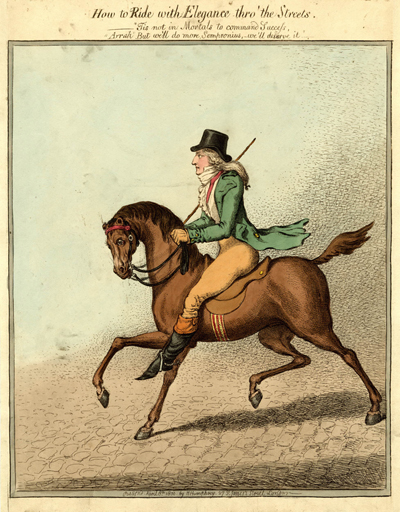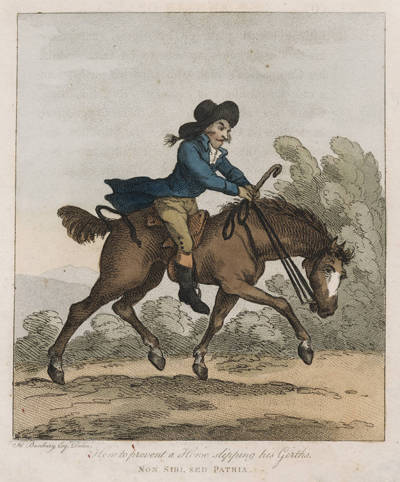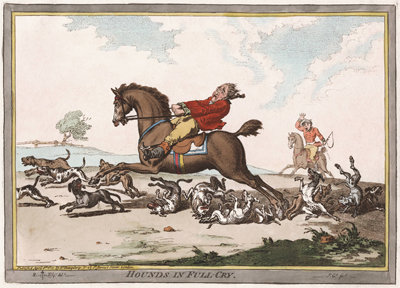How to Ride with Elegance thro' the Streets
How to Ride with Elegance thro' the Streets features Montagu Mathew, the second son of the Anglo-Irish Peer, Lord Landaff, and a recently minted (January 1st) Colonel in the British Army. At the time of the print in 1800, he was also a Member of the Irish Commons for Ballynakill, which was considering the proposal of Irish Union with England. (He was opposed to the motion.)

© Trustees of the British Museum
It's difficult to know what to do with this print. As a portrait of Montagu Mathew in profile against an essentially blank background, it seems to belong to the tradition of portrait caricature. But most portrait caricatures are titled in such a way as to hint at the subject's identity. Gillray's Georgey a' cock-horse (1796) showing George Hanger on horseback comes to mind. But in this case, there is no such hint.
There is another tradition in caricature stemming from Henry William Bunbury, which features riders having comical problems with their mounts. Examples include How to ride genteel and agreeable down Hill, How to stop your horse at pleasure, How to lose your way, and How to ride a horse upon three legs and How to prevent a horse slipping his girths. The title of this print might suggest it belongs to that comic tradition.

How to Prevent a Horse Slipping his Girths
© Lewis Walpole Library, Yale University
Indeed, on the same day as this print appeared, Gillray published four other comic prints which parody popular hunting prints, but also work within the Bunbury comic horse-and-rider tradition. They include Hounds Finding, Hounds in Full Cry, Hounds Throwing Off and Coming in at the Death.

© Lewis Walpole Library, Yale University
But Gillray's print does not immediately appear to be comic or ironic. Unlike the figures in the Bunbury print, horse and rider are, in fact, elegant.
But then there is the quotation beneath the title. It is a slightly altered version of some famous lines from Joseph Addison's Cato, A Tragedy Act I, Scene 2 which endorse the pursuit of virtue without regard to the likelihood of wordly profit.
Tis not in mortals to command success,
But we'll do more, Sempronius—we'll deserve it.
Applied to Colonel Mathew's appearance and horsemanship, the lines would appear to be quite incongruous. And that, I think, is likely the point. The pursuit of excellence in such a trivial exercise as riding with elegance through the streets is incongruous and silly, particularly while the country, like Rome at the time of Cato, is at war. If this is Gillray's point, it is certainly more obscure than most of Gillray's satiric productions. But it is at least consistent with Gillray's later portrayal of Colonel Mathew in A Pair of Polished Gentlemen as inhabiting a world which has shrunk to the dimensions of a riding boot.
NOTE: There is apparently a preliminary sketch of this print at the British Museum, but there is no image of it currently available, so I have no way of telling what changes might have been made from sketch to print.
Sources and Reading
- Commentary from the British Museum on How to Ride with Elegance thro' the Streets.
- "Montague James Mathew," Wikipedia
- Thomas Wright and R.H. Evans, Historical and Descriptive Account of the Caricatures of James Gillray #379*
- Thomas Wright and Joseph Grego, The Works of James Gillray, the Caricaturist; With the History of His Life and Times
Comments & Corrections
NOTE: Comments and/or corrections are always appreciated. To make that easier, I have included a form below that you can use. I promise never to share any of the info provided without your express permission.